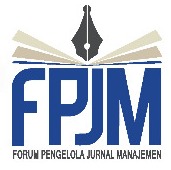Efficiency and sustainability of microfinance: Study case agribusiness microfinance institutions in Bogor
Abstract
Microfinance is one of the solutions in poverty alleviation in rural areas. The existence of financial access in a rural area, with hope, low-income society can increase their revenues and eventually able to escape the circle of poverty. The agribusiness microfinance institution is the institution that provides financing services to farmers in rural areas. However, agribusiness microfinance institution is facing sustainability problems. We analyzed financial sustainability in terms of the cost-efficiency of the Agribusiness Microfinance Institution (AMFI). The study utilized a parametric approach method of Stochastic Frontier Analysis (SFA). The sampling technique used was purposive sampling, namely AMFI possessing two years of financial reports (in the year 2016-2017) around Bogor District, there were fifteen AMFIs qualified. The result indicates AMFIs' efficiency value in Bogor District almost approaching 100%. It means that the AMFIs' financial performance in Bogor District was highly efficient. Labor cost is a very responsive variable in the total cost. However, AMFIs' labor cost was low. This matter caused administrator performance in servicing their customers to become not optimal, thus impacting the unsustainability of AMFI.
JEL Classification: G21, G23
DOI: https://doi.org/10.26905/jkdp.v23i4.3591Keywords
Full Text:
PDFReferences
Ana, L. (2012). Efisiensi bank-bank merger dan akuisisi di Indonesia. Thesis. IPB University.
Anantanyu, S. (2011). Kelembagaan petani: Peran dan strategi pengembangan kapasitasnya. Jurnal Sosial Ekonomi Pertanian dan Agribisnis, 7(2), 102–109.
Armendariz, B., & Labie, M. (2011). The handbook of microfinance. Singapore: World Scientific Publishing Co. Pte. Ltd.
Arsyad, L. (2008). Lembaga Keuangan Mikro. Institusi, kinerja dan Sustainabilitas. Yogyakarta: Penerbit Andi.
Aubert, C., de Janvry, A., & Sadoulet, E. (2009). Designing credit agent incentives to prevent mission drift in pro-poor microfinance institutions. Journal of Development Economics, 90(1), 153–162. https://doi.org/10.1016/j.jdeveco.2008.11.002
BPS (Badan Pusat Statistik-Statistics Indonesia). (2016). West Java province in figures. Bandung.
BPS (Badan Pusat Statistik-Statistics Indonesia). (2017). Bogor regency in figures. Bogor.
Bakhtiari, S. (2006). Microfinance and poverty reduction: Some international evidence. International Business & Economics Research Journal, 5(12), 65–71. https://doi.org/10.19030/iber.v5i12.3550
Berger, A. N., & Humphrey, D. B. (1997). Efficiency of financial institutions: International survey and directions for future research. European Journal of Operational Research, 98(2), 175-212. https://doi.org/10.1016/s0377-2217(96)00342-6
Berger, A. N., & Mester, L. J. (1997). Inside the black box: What explains differences in the efficiencies of financial institutions? Journal of Banking and Finance, 21(7), 895-947. https://doi.org/10.2139/ssrn.138159
Sim J., Prabhu V.V. (2014)
Sim J., & Prabhu V. V. (2014). The sustainability and outreach of microfinance institutions. IFIP Advances in Information and Communication Technology, 439, 286-293. https://doi.org/10.1007/978-3-662-44736-9_35
Dumilah, R., Juanda, G., & Khayatun Nufus. (2017). Analisis Efisiensi Biaya dengan Pendekatan Stochastic Frontier Analysis pada KBMT Kota Tangerang Selatan. Membangun paradigma kehidupan melalui multidisiplin ilmu. Pascasarjana Universitas Pamulang.
Fitzpatrick, T., & McQuinn, K. (2005). Cost efficiency in UK and Irish credit institutions. The Economic and Social Review, 36(1), 45–66.
Gul, F. A., Podder, J., & Shahriar, A. Z. M. (2017). Performance of microfinance institutions: does government ideology matter? World Development, 100, 1–15. https://doi.org/10.1016/j.worlddev.2017.07.021
Hartarska, V., Shen, X., & Mersland, R. (2013). Scale economies and input price elasticities in microfinance institutions. Journal of Banking & Finance, 37(1), 1–42. https://doi.org/10.1016/j.jbankfin.2012.08.004
Hartono, E. (2009). Analisis efisiensi biaya industri perbankan Indonesia dengan menggunakan metode parametrik Stochastic Frontier Analysis. Tesis. Universitas Diponegoro.
Hermawan, H., & Andrianyta, H. (2012). Lembaga Keuangan mikro agribisnis: Terobosan penguatan kelembagaan dan pembiayaan pertanian di perdesaan. Analisis Kebijakan Pertanian, 10, 143–158.
Hermes, N., Lensink, R., & Meesters, A. (2011). Outreach and efficiency of microfinance institutions. World Development, 39(6), 938–948. https://doi.org/10.1016/j.worlddev.2009.10.018
Littlefield, E., Morduch, J., & Hashemi, S. (2003). Is microfinance an effective strategy to reach the millennium development goals? Focus Note No. 24 CGAP.
Maesaroh, I. (2013). Analisis efisiensi biaya dengan menggunakan metode parametrik stochastic frontier analysis pada bank umum. Semnas Fekon: Optimisme Ekonomi Indonesia, 240–247.
Masood, T., & Ahmad, M. I. (2010). Technical efficiency of microfinance in India: a stochastic frontier approach. Prajnan, XXXIX(3). https://doi.org/10.2139/ssrn.1689645
Mersland, R., & Strøm, R. Ø. (2010). Microfinance mission drift? World Development, 38(1), 28–36. https://doi.org/10.1016/j.worlddev.2009.05.006
Morduch, J. (1998). Does microfinance really help the poor ? new evidence from flagship programs in Bangladesh. Research Program in Development Studies.
Mulyaningsih, Y. (2016). Analisis keberlanjutan, jangkauan dan dampak pembiayaan LKMS terhadap pengurangan kemiskinan rumah tangga tani di perdesaan Jawa Barat. Disertasi. IPB University.
Nachrowi, N., & Usman, H. (2002). Penggunaan Teknik Ekonometrika. Jakarta: PT Raja Grafindo Persada.
Nuryartono, N., Anggraenie, T., & Firdaus, R. S. (2012). Efficiency level of BPR: Study of stochastic frontier analysis with an approach of time varying decay. International Research Journal of Finance and Economics, 85(January), 6–13.
Sim, J., & Prabhu, V. V. (2014). The sustainability and outreach of microfinance institutions. IFIP Advances in Information and Communication Technology, 439 (Part 2), 286–293. https://doi.org/10.1007/978-3-662-44736-9_35
Suharyadi, & Sumarto, A. H. (2017). Analisis efisiensi industri perbankan Indonesia dengan menggunakan metode parametrik distribution free approach. Jurnal Ilmiah Manajemen, VII(1), 80–96.
Usman, S., Suharyo, W. I., Soelaksono, B., Toyamah, N., Mawardi, M. S., & Akhmadi. (2004). Keuangan mikro untuk masyarakat miskin: pengalaman Nusa Tenggara Timur. Jakarta. Lembaga Penelitian SMERU.
Yaron, J. (1994). What makes rural finance institutions successful? The World Bank Research Observer, 9, 49–70.
Zeller, M., & Meyer, R. L. (2002). The triangle of microfinance: financial sustainability, outreach, and impact. Baltimore and London: The Johns Hopkins University Press.
DOI: https://doi.org/10.26905/jkdp.v23i4.3591
Refbacks
- There are currently no refbacks.
Jurnal Keuangan dan Perbankan (Journal of Finance and Banking)
Diploma Program of Banking and Finance, Faculty of Economics and Business, University of Merdeka Malang
Published by University of Merdeka Malang
Mailing Address:
2nd floor Finance and Banking Building, Jl. Terusan Raya Dieng No. 57 Malang, East Java, Indonesia
Phone: +62 813-3180-1534
Email: jkp@unmer.ac.id
 This work is licensed under a Creative
This work is licensed under a Creative
Commons Attribution-ShareAlike 4.0




